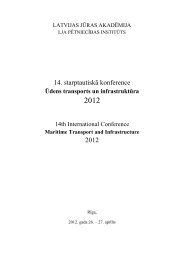Create successful ePaper yourself
Turn your PDF publications into a flip-book with our unique Google optimized e-Paper software.
ConclusionsIt can be assumed that global shortage of officers will remain one of the topics for maritime societyat least for few next years. Supply side of demand/supply equation should be considered by taking intoaccount not only the number of graduates from educational institutions but also the level of maritimeeducational programme, number of persons continuing their education, number of persons leaving pooland dropout rate from active seafarers’ pool and its relation to previous educational level. It can beconcluded that educational institution and received education has impact on probability that person willjoin the active seafarers’ pool and how long they will stay there. Careful consideration can be derived thatgraduates completing higher level maritime educational programmes are attracted to shore industry inlarger extent than others and for them it is easier to find employment ashore. However this can be linkedto differences in individuals and differences in their motivation to study in one or another maritimeeducation institution as those parameters cannot be analysed by using the bulk data from database.Historical analysis of graduates provides information about factors which are influenced by receivedmaritime education and therefore those parameters can be applied in modelling future supply of <strong>Latvian</strong>seafarers even the structure of maritime educational system is different. Those analyses also show thatsuch parameter as career growth on board cannot be directly assigned for received maritime educationand are influenced more by demand side than by supply side. In future additional data analysis isprerequisite to consider influence of external factors such as unemployment, average salary ashore inLatvia and other factors to provide data for complete supply model of <strong>Latvian</strong> seafarers.References1. International <strong>Maritime</strong> Organisation (2008). IMO official web page. Available (accessed on05.04.2013): http://www.imo.org/ourwork/humanelement/gotosea/Pages/Default.aspx2. BIMCO (2010). Manpower 2010 update. Available (accessed on 05.04.2013):https://www.bimco.org/en/News/2010/11/~/media/About/Press/2010/Manpower_Study_handout_2010.ashx3. Glen, D. What do we know about the labour market for seafarers? Marine Policy, Vol. 32, 2008,pp. 845-855.4. Study on EU Seafarers Employment. European Commission, 2011.5. Report of the Task Force on <strong>Maritime</strong> Employment and Competitiveness and Policy. EuropeanCommision, 2011.6. Mitroussi, K. Employment of seafarers in the EU context: challenges and opportunities. MarinePolicy, Vol. 32 (6), 2008, pp. 1043-1049.7. Benito, G. et. al. A cluster analysis of the maritime sector in Norway. International Journal ofTransport Management, Vol. 1, 2005, pp. 203–215.8. Wu, B., Winchester, N. Crew study of seafarers: a methodological approach to the global labourmarket for seafarers. Marine Policy, Vol. 29, 2005, pp. 323–330.9. Li, K., Wonham, J. A method for estimating world maritime employment. TransportationResearch Part E 35, 1999, pp. 183- 189.10. Pettit, S. et. al. Ex-seafarers shore-based employment:the current UK situation. Marine Policy,Vol. 29, 2005, pp. 521-531.11. Alderton, T., Winchester, N. Globalisation and de-regulation in the maritime industry. MarinePolicy, Vol. 26, 2006, pp. 35-43.12. Sornn‐Friese, H., Hansen, C. Ø. The Blue Denmark: Is it a maritime labour mobility cluster?Copenhagen: Center for shipping economics and innovation, 2005.13. Corres, A. J. Greek <strong>Maritime</strong> Policy and the Discreet Role of Shipowners’ Associations.Research in Transportation Economics, Vol. 21, 2007, pp. 221–255.14. The Mapping of Career Paths in <strong>Maritime</strong> Industries. Southampton Solent University, 2005.12
















